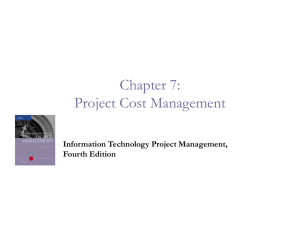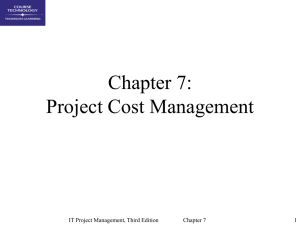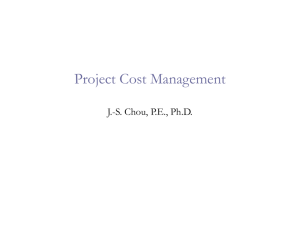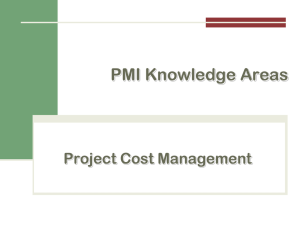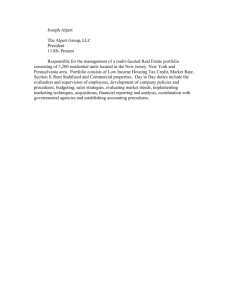Project Cost Estimation and Management Presentation
advertisement
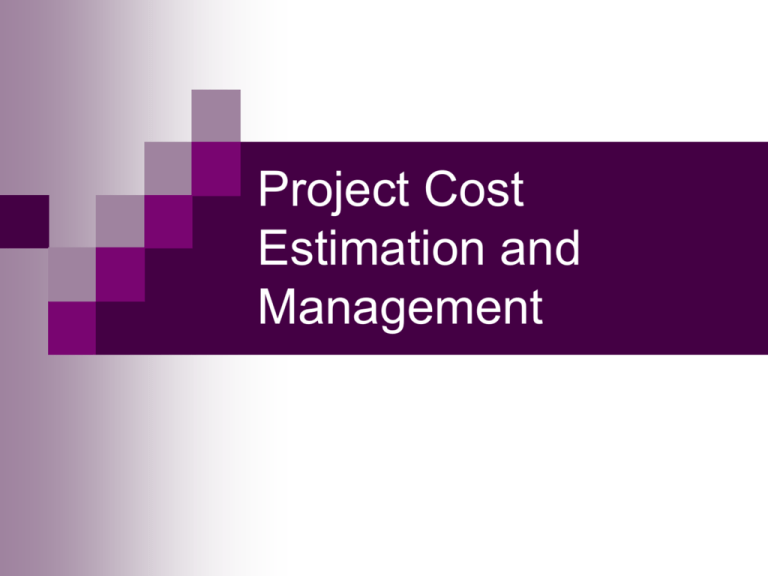
Project Cost Estimation and Management Learning Objectives Understand the importance of project cost management. Explain basic project cost management principles, concepts, and terms. Discuss different types of cost estimates and methods for preparing them. Learning Objectives Understand the processes involved in cost budgeting and preparing a cost estimate and budget for an information technology project. Understand the benefits of earned value management and project portfolio management to assist in cost control. Describe how project management The Importance of Project Cost Management IT projects have a poor track record for meeting cost goals Average cost overrun from 1995 CHAOS study was 189% of the original estimates; improved to 145% in the 2001 study The 2003 CHAOS studies showed the average cost overrun (the additional percentage or dollar amount by which actual costs exceed estimates) was 43 percent. In 1995, cancelled IT projects cost the U.S. over $81 billion U.S. lost $55 billion in IT projects in 2002 from cancelled projects and overruns compared to $140 billion in 1994.* *The Standish Group, “Latest Standish Group CHAOS Report Shows Project Success Rates Have Improved by 50%,” A Standish Group Research Note (3/25/03). What Went Wrong? According to the San Francisco Chronicle front-page story, "Computer Bumbling Costs the State $1 Billion," the state of California had a series of expensive IT project failures in the late 1990s, costing taxpayers nearly $1 billion…ironic that the state which leads in creation of computers is the state most behind in using computer technology to improve state services. …The Internal Revenue Service (IRS) managed a series of project failures that cost taxpayers over $50 billion a year—roughly as much money as the annual net profit of the entire computer industry. …Connecticut General Life Insurance Co. sued PeopleSoft over an aborted installation of a finance system. What is Cost and Project Cost Management? Cost is a resource sacrificed or foregone to achieve a specific objective or something given up in exchange Costs are usually measured in monetary units like dollars Project cost management includes the processes required to ensure that the project is completed within an approved budget Project Cost Management Processes Resource planning: determining what resources and quantities of them should be used Cost estimating: developing an estimate of the costs and resources needed to complete a project Cost budgeting: allocating the overall cost estimate to individual work items to establish a baseline for measuring performance Cost control: controlling changes to the project budget Basic Principles of Cost Management Most CEOs and boards know a lot more about finance than IT, so IT project managers must speak their language Profits are revenues minus expenses Life cycle costing is estimating the cost of a project plus the maintenance costs of the products it produces Cash flow analysis is determining the estimated annual costs and benefits for a project Benefits and costs can be tangible or intangible, direct or indirect Sunk cost should not be a criteria in project selection Cost of Software Defects When Defect is Detected User Requirements Coding/Unit Testing System Testing Acceptance Testing After Implementation Typical Cost of Correction $100-$1,000 $1,000 or more $7,000 - $8,000 $1,000 - $100,000 Up to millions of dollars It is important to spend money up-front on IT projects to avoid spending a lot more later. Basic Principles of Cost Management Tangible costs or benefits are those costs or benefits that an organization can easily measure in dollars. Intangible costs or benefits are costs or benefits that are difficult to measure in monetary terms. Direct costs are costs that can be directly related to producing the products and services of the project. Indirect costs are costs that are not directly related to the products or services of the project, but are indirectly related to performing the project. Sunk cost is money that has been spent in the past; when deciding what projects to invest in or continue, you should not include sunk costs. Basic Principles of Cost Management Learning curve theory states that when many items are produced repetitively, the unit cost of those items decreases in a regular pattern as more units are produced. Reserves are dollars included in a cost estimate to mitigate cost risk by allowing for future situations that are difficult to predict. Contingency reserves allow for future situations that may be partially planned for (sometimes called known unknowns) and are included in the project cost baseline. Management reserves allow for future situations that are unpredictable (sometimes called unknown unknowns). Resource Planning The nature of the project and the organization will affect resource planning Some questions to consider: How difficult will it be to do specific tasks on the project? Is there anything unique in this project’s scope statement that will affect resources? What is the organization’s history in doing similar tasks? Does the organization have or can they acquire the people, equipment, and materials that are capable and available for performing the work? Cost Estimating An important output of project cost management is a cost estimate There are several types of cost estimates and tools and techniques to help create them It is also important to develop a cost management plan that describes how cost variances will be managed on the project Types of Cost Estimates Type of Estimate Rough Order of Magnitude (ROM) Budgetary Definitive When Done Why Done How Accurate Very early in the project life cycle, often 3–5 years before project completion Early, 1–2 years out Provides rough ballpark of cost for selection decisions –25%, +75% Puts dollars in the budget plans –10%, +25% Later in the project, < 1 year out Provides details for purchases, estimate actual costs –5%, +10% Cost Estimation Tools and Techniques 3 basic tools and techniques for cost estimates: analogous or top-down: use the actual cost of a previous, similar project as the basis for the new estimate bottom-up: estimate individual work items and sum them to get a total estimate parametric: use project characteristics in a mathematical model to estimate costs Cost Management Plan A cost management plan is a document that describes how the organization will manage cost variances on the project. A large percentage of total project costs are often labor costs, so project managers must develop and track estimates for labor. Table 7-3. Maximum Departmental Headcounts by Year A large percentage of the costs of many IT projects are human resource costs. Constructive Cost Model (COCOMO) Barry Boehm helped develop the COCOMO models for estimating software development costs Parameters include source lines of code or function points Function points: Technology-independent assessments of the functions involved in developing a system. Source Lines of Code (SLOC): A human-written line of code that is not a blank line or comment. COCOMO II is a computerized model available on the Web Boehm suggests that only parametric models do not suffer from the limits of human decision-making Ex. http://www.jsc.nasa.gov/bu2/COCOMO.html Typical Problems with IT Cost Estimates Developing an estimate for a large software project is a complex task requiring a significant amount of effort. Remember that estimates are done at various stages of the project Many people doing estimates have little experience doing them. Try to provide training and mentoring People have a bias toward underestimation. Review estimates and ask important questions to make sure estimates are not biased Management wants a number for a bid, not a real estimate. Project managers must negotiate with project sponsors to create realistic cost estimates Sample Cost Estimate See pages 262-266 for a detailed example that describes how to create a cost estimate for the Surveyor Pro project described in the opening case. Before creating an estimate, know what it will be used for, gather as much information about the project as possible, and clarify the ground rules and assumptions for the estimate. If possible, estimate costs by major WBS categories. Create a cost model to make it easy to change and document the estimate. Figure 7-1. Surveyor Pro Project Cost Estimate Figure 7-2. Surveyor Pro Software Development Estimate Cost Budgeting Cost budgeting involves allocating the project cost estimate to individual work items and providing a cost baseline For example, in the Business Systems Replacement project, there was a total purchased cost estimate for FY97 of $600,000 and another $1.2 million for Information Services and Technology These amounts were allocated to appropriate budgets as shown in the next slide Figure 7-3. Surveyor Pro Project Cost Baseline Cost Control Project cost control includes monitoring cost performance ensuring that only appropriate project changes are included in a revised cost baseline informing project stakeholders of authorized changes to the project that will affect costs Earned value management is an important tool for cost control Media Snapshot Australia: Problems with the installation of an ERP system at Crane Group Ltd. led to an estimated cost overrun of $11.5 million.* India: As many as 274 projects currently under implementation in the Central sector are suffering serious cost and time overruns.** Pakistan: Pakistan has sustained a cost overrun of Rs 1.798 billion (over $30 million U.S. dollars) in the execution of the 66.5 megawatt Jagran Hydropower Project in the Neelum Valley.*** United States: Northern California lawmakers were outraged over Governor Arnold Schwarzenegger's announcement that commuters should have to pay construction costs on Bay Area bridges. Maybe it takes the Terminator to help control costs!**** *Songini, Marc L., “Australian Firm Wrestles With ERP Delays,” ComputerWorld (July 12, 2004). **Srinivasan, G., “274 Central sector projects suffer cost, time overruns,” The Hindu Business Line (May 4, 2004). ***Mustafa, Khalid, “Rs 1.8 billion cost overrun in Jagran hydropower project,” Daily Times (November 19, 2002). ****Gannett Company, “Governor Refuses to Pay for Bay Bridge Cost Overruns,” News10 (August 17, 2004). Earned Value Management (EVM) EVM is a project performance measurement technique that integrates scope, time, and cost data Given a baseline (original plan plus approved changes), you can determine how well the project is meeting its goals You must enter actual information periodically to use EVM. Figure 7-1 shows a sample form for collecting information Figure 7-1. Cost Control Input Form for WBS#: 6.8.1.2 Business Systems Replacement Project Design Interface Process Customer Information Description: Assignments SMC Role: PA Availability: Involved: Role: Availability: Involved: Role: Availability: Involved: Role: Availability: 6 Optimistic: Effort (in hours) Most Likely: 20 30 Pessimistic: 40 Develop an operational process design for the Customer Information interface from the Invoicing System to Oracle Receivables. This task will accept as input the business/functional requirements developed during the tactical analysis phase and produce as output a physical operational design, which provides the specifications, required for code development. Process Design Document - Technical - Operation/Physical DFD - Process Specifications - Interface Data Map Calculated Plan Effort: Plan Duration : 30 5 Hrs Days Delay (Days): Description Results / Deliverables Revision Date: Forecast Hours per day Responsible: Revision: Assumptions - All business rules and issues will be resolved prior to this task. - The ERD & data model for Oracle Receivables & any Oracle extension required will be completed and available prior to this task . - The ERD for the Invoicing System will be completed and available prior to this task. - Few iterations of the review/modify cycle will be required. - Primarily a documentation task. Dependencies Predecessors (WBS#): 4.7 Successors (WBS#): Earned Value Management Terms The planned value (PV), formerly called the budgeted cost of work scheduled (BCWS), also called the budget, is that portion of the approved total cost estimate planned to be spent on an activity during a given period Actual cost (AC), formerly called actual cost of work performed (ACWP), is the total of direct and indirect costs incurred in accomplishing work on an activity during a given period The earned value (EV), formerly called the budgeted cost of work performed (BCWP), is an estimate of the value of the physical work actually completed Rate of Performance Rate of performance (RP) is the ratio of actual work completed to the percentage of work planned to have been completed at any given time during the life of the project or activity. Brenda Taylor, Senior Project Manager in South Africa, suggests using this approach for estimating earned value. For example, suppose the server installation was halfway completed by the end of week 1. The rate of performance would be 50 percent (50/100) because by the end of week 1, the planned schedule reflects that the task should be 100 percent complete and only 50 percent of that work has been completed. Earned Value Calculations Earned Value Formulas Rules of Thumb for Earned Value Numbers Negative numbers for cost and schedule variance indicate problems in those areas. The project is costing more than planned or taking longer than planned CPI and SPI less than 100% indicate problems Earned Value Calculations for a OneYear Project After Five Months Earned Value Chart Project Portfolio Management Many organizations collect and control an entire suite of projects or investments as one set of interrelated activities in a portfolio. Project portfolio management has five levels: 1. 2. 3. 4. 5. Put all your projects in one database. Prioritize the projects in your database. Divide your projects into two or three budgets based on type of investment. Automate the repository. Apply modern portfolio theory, including risk-return tools that map project risk on a curve. Benefits of Portfolio Management Schlumberger saved $3 million in one year by organizing 120 information technology projects into a portfolio. META Group research shows that: Organizations that evaluate information technology projects by what their business impacts are and what their potential business values will be implement projects that result in 25 percent more improvement to the bottom line. By 2005-2006, more than 50 percent of the CIOs for Global 2000 companies will adopt project portfolio management tools and techniques for IT projects, asset management, and budget planning and monitoring. Business executives state that using project portfolio management allows managers to make decisions faster and with more confidence.* *META Group, “IT Investment Management: Portfolio Management Lessons Learned,” A META Group White Paper (www.metagroup.com) (2002). Using Software to Assist in Cost Management Spreadsheets are a common tool for resource planning, cost estimating, cost budgeting, and cost control. Many companies use more sophisticated and centralized financial applications software for cost information. Project management software has many cost-related features, especially enterprise PM software. Figure 7-6. Sample Project Portfolio Management Screen Showing Project Health Chapter Summary Project cost management is traditionally a weak area in IT projects, and project managers must work to improve their ability to deliver projects within approved budgets. Main processes include: Cost estimating Cost budgeting Cost control In Class Activity Earned Value Calculation Handout
